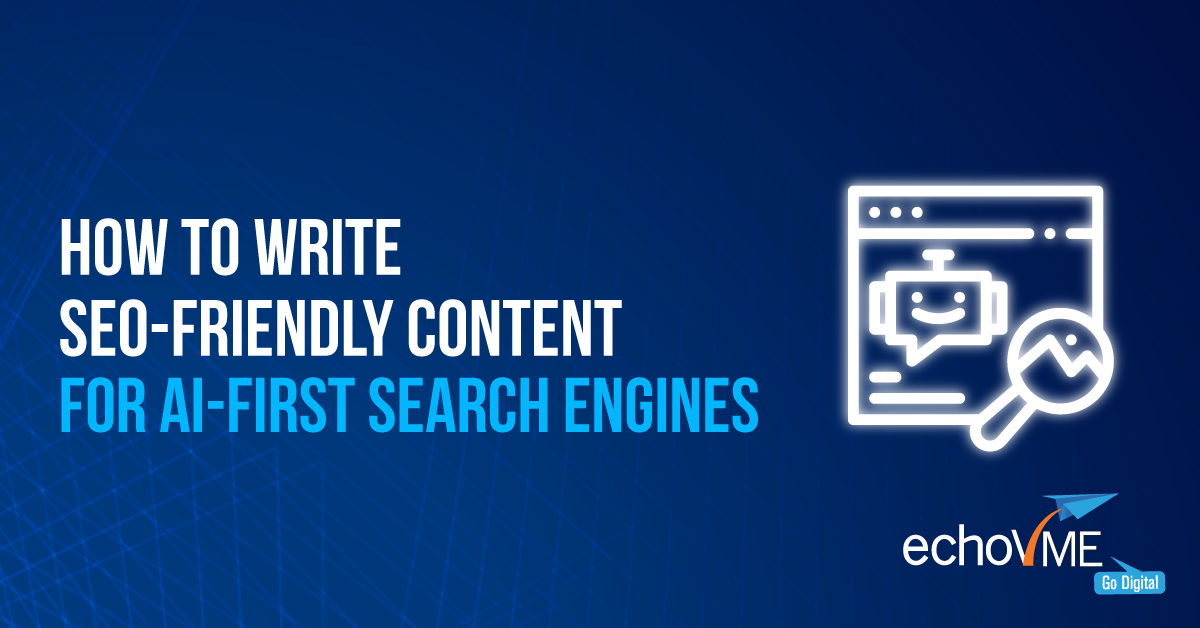The content-making process is always going through mounting changes in terms of visibility and ranking. The current content visibility stretches to getting your content up in AI search engines and adopting GEO practices. With AI-first search engines like Google’s SGE (Search Generative Experience) and Microsoft’s Bing Copilot, the traditional keyword strategy has taken a backseat. Search is no longer about exact matches— understanding intent, context, and meaning should be your intent now

echoVME Digital: Empowering Your Brand with 360° Marketing
Partner with echoVME Digital for full-spectrum marketing solutions — SEO, content, social, paid media, creative, and more. Drive real growth with a team that handles it all. Let’s grow your brand together!
Introduction: The AI-First Revolution in Search
Gone are the days when simply stuffing your content with exact-match keywords was enough. Those tactics are now relics of the past. The new focus is on crafting content that truly speaks to how Artificial Intelligence, or AI, understands the world. Search engines, especially those powered by artificial intelligence, are getting much smarter. They’re not just matching words. They’re trying to understand what someone wants when they type something in.
The AI recognises what the humans ask based on frequent requests. This means our content needs to be more human, more helpful. We must anticipate the questions people are actually asking, not just the words they type. Google’s algorithms are now better at grasping the meaning behind searches. They can figure out synonyms and related concepts.
For digital marketers, this shift isn’t just another Google update. It’s how content is adapted, created, ranked, and consumed. This blog will guide you through the nuances of writing SEO-friendly content tailored for AI-first search engines, ensuring that your content ranks well and engages readers effectively.
How AI Interprets Content
Search engines powered by AI no longer just crawl for keywords, so to write effectively for AI-driven search engines, it’s essential to understand how these systems interpret content.
To understand this, you have to know and understand 3 things: NLP(Natural Language Processing), semantics search and contextual SEO.
NLP (Natural Language Processing):
NLP allows AI to examine the arrangement, context, and connections among words in a search query. This enables search engines to grasp the subtleties of human language and determine the user’s intention, even when the query is expressed unusually. NLP methods like named entity recognition, sentiment analysis, and discovering the primary subjects help in comprehending the search intent.
Semantics search:
AI search engines operate on semantic search principles, meaning they understand the relationships between concepts, synonyms, and contextual meanings. When someone searches for “best pizza in Chennai,” AI doesn’t just look for pages containing those exact words. Instead, it understands the user wants recommendations for high-quality pizza restaurants in Chennai, considering factors like reviews, location, menu variety, and user preferences.
Contextual SEO:
Contextual SEO, sometimes referred to as contextual link building, is an SEO tactic that emphasises creating links inside the body of pertinent, excellent web pages. These links, also referred to as contextual links, are incorporated into the text’s body and are essential for raising a website’s search engine rating and general SEO effectiveness.
Writing for AI-First Optimisation: A Step-by-Step Approach

Creating content for AI-first optimisation involves several strategic steps. Let’s break down exactly how to create AI-first content writing that doesn’t just rank, but dominates AI-powered search results.
1. Research Beyond Keywords
The very first step to make a spotlight content is brushing off all the keywords that rank. AI-first content demands understanding and a strong hold on the subject matter.
Here is what you need to do:
- Identify the gaps: Look beyond what competitors are covering and identify what they’re missing. AI rewards comprehensive coverage that addresses user questions competitors haven’t considered.
- Create Topic Clusters: Instead of targeting individual keywords, build content clusters around comprehensive topics. Create supporting content about regional trends, platform preferences, audience demographics, and campaign strategies.
- Use AI-Powered Research Tools: Use tools like Google’s “People Also Ask” and Answer the Public to map contextual queries.
2. Craft Semantically Rich, Comprehensive Answers
When writing, aim to provide thorough answers to potential questions. Structure content to address logical follow-up questions. For instance, if discussing influencer marketing ROI, naturally, progress to measurement methods, industry benchmarks, and optimisation strategies. AI favours varied content types. Mix text with lists, tables, quotes, and structured data.
| Did you know? Creating content with different structures and formats receives 67% more AI visibility. |
3. Break Down Content Using Clear Headings
AI search engines love well-organised content. Here’s the structure that consistently performs:
Hierarchical Heading Structure: Organise your content with clear headings and subheadings. Use H1-H6 tags logically. This not only improves readability but also creates a clear content hierarchy that AI can easily understand.
Conversational Tone with Authority: Balance approachable language with expertise. AI recognises authoritative tone while rewarding readability.
Schema Markup Integration: Implement relevant schema markup to help AI understand content context, relationships, and structure.
Geotargeting and Local SEO: The Chennai Connection
Local SEO is particularly crucial in an AI-first content. AI-driven engines tailor responses based on location, culture, and intent. Let’s analyse and understand geo-targeted content using Chennai as our prime example,
Localising Content for AI-First Search
The AI era requires sophisticated localisation that goes beyond merely mentioning the city name. AI search engines understand local context, cultural nuances, and regional preferences with remarkable precision.
Cultural Context Integration: When creating content for Chennai audiences, reference local landmarks, events, and cultural elements. Mentioning areas like T. Nagar for shopping or Marina Beach for recreation helps AI understand local relevance.
Regional Language Integration: While writing in English, naturally incorporate Tamil phrases or references that Chennai residents would understand. AI recognises this cultural authenticity and rewards it with better local visibility.
For instance: Instead of generic “best restaurants,” optimise for “best Chettinad restaurants near Express Avenue Chennai” or “authentic filter coffee spots in Mylapore.”
Formatting and Publishing Best Practices
The technical side of AI-first content writing can make or break your search visibility. To optimise your content for AI crawling and understanding, consider the following best practices:
Optimising Structure with Lists and Media: To improve interest, break up material, and create a visual appeal, use photos, numbered lists, and bullet points. This helps AI process your content and enhances the user experience.
Featured Snippet Optimisation: Structure content to directly answer common questions within 50-60 words. Add your primary keyword once here to get recognised by AI.
Conversational Voice: AI search engines increasingly favour content that sounds natural and engaging. Write in a friendly, approachable tone. Engaging content that feels personal is more likely to resonate with readers and encourage shares.
Technical Enhancements for AI Crawling: Ensure your website is technically sound with fast loading times, mobile optimisation, and secure HTTPS protocols. AI search engines love fast-loading content.
Practical Implementation Roadmap: A picture view
For digital marketers ready to embrace AI-first content writing:
- Audit Current Content: Evaluate existing content for semantic richness and comprehensive topic coverage
- Develop Topic Clusters: Create interconnected content hubs around primary business topics
- Implement Conversational Optimisation: Use conversational, natural language patterns when rewriting important pages.
- Monitor AI Search Performance: Use emerging analytics tools to track performance in AI-powered search results
- Iterate and Improve: Continuously refine content based on AI search performance data
Future Trends and Takeaways for Content Writers
As AI search technology continues to evolve, so too must our content strategies.. Here’s what you need to remember: context, semantics, and user intent now drive visibility. Your best result comes when you do everything right: Research, Structure, Experiment formats, develop local content and make a technically sound website.
Remember that at its core, AI-first content writing is about creating genuinely valuable, comprehensive content that serves users’ needs with quality, and fear not, the AI revolution, because it isn’t making good content obsolete—but, making it more important than ever.
Frequently Asked Questions
1. How to write SEO friendly content using AI?
To succeed in AI-first optimisation, go beyond keywords: identify content gaps, build topic clusters, and use AI tools for contextual queries. Provide semantically rich, comprehensive answers with varied formats like tables and FAQs. Structure content with clear headings, a conversational yet authoritative tone, and schema markup. This ensures readability, context clarity, and higher AI-driven visibility.
2. Are keywords still important in AI-first SEO?
Although keywords are still crucial, their function has changed considerably. Instead of repeating exact matches, concentrate on semantic keyword clusters, which are collections of similar terms that organically bolster your primary topic.
3. What is semantic search?
Instead of only matching words, semantic search allows AI to comprehend the relationships and meanings of concepts. In terms of content strategy, this involves focusing on thorough topic coverage, responding to pertinent queries, and organising information into clusters based on themes rather than specific keywords.
4. What types of content are most effective for AI-first search engines?
Comprehensive, semantically rich content that answers user queries and provides valuable insights tends to perform best in AI AI-first engine. Such content answers exactly what the user is looking for.
5. What are some best practices for formatting content?
AI search engines favour well-structured, multi-format content including clear hierarchical headings (H1-H6), bullet points and numbered lists, FAQ sections, tables and comparison charts, relevant images with descriptive alt text, embedded videos, schema markup, and scannable content with short paragraphs.
6. How do I optimise for AI-overview snippets?
Provide structure to your content that visually appeals and is well formatted, make your FAQs rich and informative, and provide concise answers that directly match user intent.
7. How can schema markup help AI-first SEO?
Schema helps AI understand your content structure, improving the chances of appearing in rich snippets.
8. Does AI prefer long-form or short content?
AI recognises long-form, comprehensive content better, which deeply covers a topic with clarity. But that doesn’t mean short-form content is appreciated. If your content answers exactly what users search for, it can get better results.
9. What are the most common mistakes to avoid for AI-first content writing?
Keyword stuffing or unnatural keyword usage, creating content that doesn’t comprehensively cover topics, ignoring user intent, poor content structure without clear headings, neglecting local/cultural context for geo-targeted content, are some common mistakes made by writers.
10. How can I measure the effectiveness of my AI-first content?
Measure AI-first content writing success through AI search visibility tracking, featured snippet captures, voice search performance, user engagement metrics, semantic keyword ranking improvements, local search visibility (for geo-targeted content), and content comprehensiveness scores. Use tools like Google Search Console to track performance.



